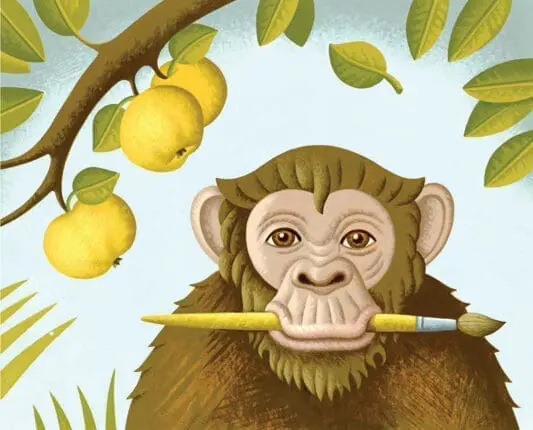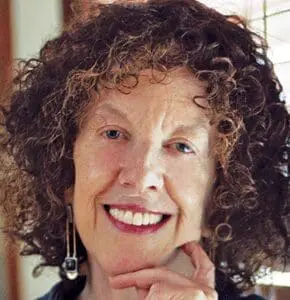When I was four and my sister Susan was nine, I swallowed an apple seed. Susan, whom I worshiped and whose every word I believed, told me that a tree was going to grow in my stomach. I insisted that it wasn’t possible, since trees need sunshine to grow, but Susan, who later went on to become a biologist, had an answer for everything. She reminded me that it was dark and damp in the ground where seeds are planted, making my stomach just the right place for a seed to take root. When the branches of my apple tree got big enough, she explained, they’d grow out of my ears and get all the sunshine they needed.
“Don’t tell Mommy and Daddy!” Susan warned me, explaining that our parents would only worry, since there was nothing they could do to fix the problem. Not even the doctor could help. She advised me to drink as little water as possible in order to slow the growth process, and she reassured me that when the tips of the branches began to grow out of my ears, she’d clip them off with scissors.
At night, in our shared bedroom, I’d ask Susan to look into my ears with a flashlight to see how the apple tree was growing. “I can see it!” she’d exclaim. “I’m almost sure I can see the tip of a branch down there!” As I lay very still in bed, I could almost feel the tree growing, and as I pictured what I’d look like with branches growing from my ears, I imagined a lot of problems.
I don’t remember how long I kept the secret, but I do recall the night I collapsed on my bed after dinner and broke down. My mother, hearing my sobs from the kitchen, rushed into the bedroom to investigate my distress. At first, I said no more than that I had a terrible secret, that something bad had happened to me, and that there was nothing she could do to help.
My mother, whom I can now picture as imagining the worst, firmly stated that she was not leaving my side until I told her what was going on. When it became clear that she meant it, I told her the awful truth, as I knew it. “I’m growing a tree.” I sobbed.
“What?” she exclaimed. “What?”
“I swallowed an apple seed,” I repeated. “Susan can already see the tips of the branches with her flashlight.” The story came tumbling out.
My mother yelled, “Susan, get in here right now!”
The rest is a blur, except that my big sister came clean. Perhaps she hadn’t known that a lie could grow so big, just like a seed grows into a tree. Surely, the bigger the lie, the harder it was to tell the truth.
For my part, I was too relieved to even begin to feel angry with her, because now I was just like other little girls. Birds wouldn’t build a nest in my branches. I wouldn’t have to go to the woodcutter to get a haircut. I wouldn’t get stuck in the school bus door. I wouldn’t be used as a coat rack in winter when the leaves fell off. Growing up would be difficult enough without having to worry about these things.

Luckily, Susan didn’t always use her vivid imagination in the service of torturing me. She was a fiercely protective big sister, especially when I was seven and she was twelve, and we moved from the cramped apartment where we shared a bedroom to a big old house in Brooklyn. Our parents were poor, and while they’d somehow managed to come up with the down payment, everything in the house stopped working after we moved in.
Although the endless repairs left my parents broke, our mother’s panic about money was pretty much a joke to Susan and me. How could we be that poor, when we each had our own room in a three-story house? When the holiday season rolled around and Susan said she wanted an encyclopedia set and I said I wanted a bike, our parents told us that these gifts were unaffordable, but we knew they were only saying it so that we’d be more delighted and surprised when we saw them.
When the time came to open presents, Susan and I rushed downstairs to find two small rectangular packages sitting on the kitchen table where my parents were having coffee. I was immediately disappointed, since there was no way to fit a bike into that little box, but we both ripped off the paper, eager to see what was inside. We had the exact same gifts: incredibly cheesy-looking metal tissue holders painted black with corny colored roses all over them.
Here’s the rest of the story as Susan wrote it for an English class many years later, capturing the voice of her 12-year-old self.
Well, Harriet started to cry, and I was all ready to join in, even though I was too old for that sort of thing, but then I saw my mother’s face, and it looked like she was ready to cry. I hate to see grown-ups cry, and I knew she must be even unhappier than us that they couldn’t get us nice gifts, and I knew she didn’t like accepting charity, like these boxes must have been from my father’s friend who made them.
So instead of crying, I smiled as hard as I could, and I kissed my parents and said that the box was perfectly gorgeous and I was going to put it on my vanity table as soon as I got a vanity table, and that it would probably bring me good luck and I’d get boyfriends, although I certainly didn’t want any of them hanging around. It sure made my mother feel good. Then my father cheered up and said he bet I’d be the belle of the ball if I used that tissue box.
Harriet was so surprised to see that I liked the box that she stopped crying, and she was kind of standing there with her jaw hanging open like she does sometimes, and then I got this inspiration. I told Harriet that those boxes were painted by trained monkeys! At first, she didn’t believe it, but I just kept on talking and talking and pretty soon I almost believed it.
I told Harriet all about those monkeys and what they ate and how they got paid in bananas and peanuts, and how they were trained when they were very little, and how some painted the boxes black and some painted the stems, and the most intelligent ones painted the roses, which are the hardest. And she got so excited (you may not believe all this, but it’s true) that she just kissed my parents and started giggling and decided that she loved her tissue box. And she really does, because she always keeps it out on her bureau.
Well, my parents were feeling much better, but the funny thing is that I just rushed upstairs and started crying all over my pillow. And I wasn’t sad about the gift, really. I wasn’t even exactly sure what I was crying about, except that it was just as if I’d given up letting people do things for me, and now I’d volunteered to be a grown-up before I was even ready for it.
I found this composition rummaging through Susan’s papers when I was home from the University of Wisconsin at spring break one year. As I sat on the floor of her bedroom reading it for the first time, I almost began to cry myself. As the baby of the family, I’d never thought about the emotional position of the firstborn. But the real jolt came from the sudden discovery, as a college student at age 19, that trained monkeys hadn’t painted my tissue box. I’d taken her story on faith—a testimony to the power of older sisters and the gullibility of younger ones, and a testimony to a gift that was so singularly ugly that it wasn’t entirely crazy to convince myself that trained monkeys had done the job.
Even now, although I’m not sure where the tissue box has ended up in the sea of possessions that have come and gone over these last many decades, the monkeys are alive and well, at least in family lore and among my friends. “That must have been hand painted by trained monkeys,” my sister will comment if we spot a particular tasteless piece of kitsch. When I make cards for my friends, I may put a teensy note on the back: “This card was painted by trained monkeys.” My kids know about the trained monkeys and don’t hesitate to bring them into conversations.

Susan’s incredible imagination kept offering itself to me over the years, but as we both got a bit older, she invited me to be a partner in crime—a big step up from my role as the gullible younger sister. One of my most cherished childhood memories is riding the train from Brooklyn to Manhattan so Susan could take me to the fanciest stores on Fifth Avenue, where she planned for us to masquerade as millionaires.
Our first stop was Tiffany’s. “Do you think we should buy Mother this diamond necklace for her birthday?” I inquired loudly of Susan, pointing to the most expensive item in view and attempting to capture the attention of the well-heeled shoppers nearby.
“Oh, don’t be silly!” Susan replied in her most grown-up, haughty voice. “Mother has several exactly like it, you know.” Looking like street urchins in our ill-fitting thrift-store clothing, we fooled no one but ourselves, yet in this way we spent many happy, memorable afternoons.
Although I was thrilled to be granted the status of an almost-equal partner in her world of pretending, the tissue-box story remains iconic of my childhood, emblematic of the profound influence that Susan’s imagination had on my younger self, as well as the vastly different worlds that the firstborn and younger child inhabit in the drama of family life. It’s emblematic, too, of the enduring power of the stories that siblings tell each other—and the tenderness that can be tucked into deception.
I can still picture the school in the jungle where a select group of monkeys receive training and do their work. These monkeys are the chosen ones. They’re all cheerful and proud, even those lowest in the hierarchy, the least talented ones who paint the single-colored backgrounds. Especially proud are the monkeys who paint the most difficult parts, like flowers, butterflies, and rainbows. They’re so skilled that the final product looks like it came off an assembly line. The very smartest monkeys are that precise.
ILLUSTRATION BY ADAM NIKLEWICZ
Harriet Lerner
Harriet Lerner is one of the most respected voices on the psychology of women and marriage and family relationships. For more than three decades, she was a staff psychologist and psychotherapist at The Menninger Clinic in Topeka, Kansas, and a faculty member and supervisor in the Karl Menninger School of Psychiatry. Currently in private practice in Lawrence, Kansas, she is the author of numerous scholarly articles and 12 books, including the New York Times best-seller, The Dance of Anger, and Why Won’t You Apologize: Healing Big Betrayals and Everyday Hurts.













